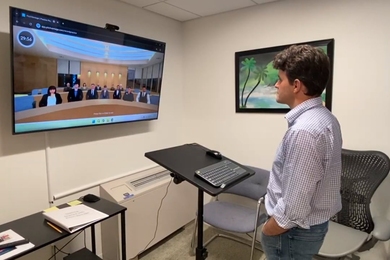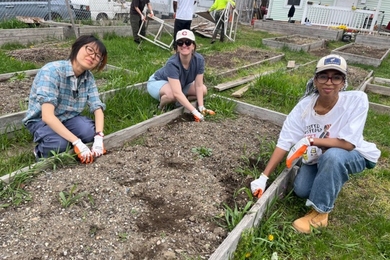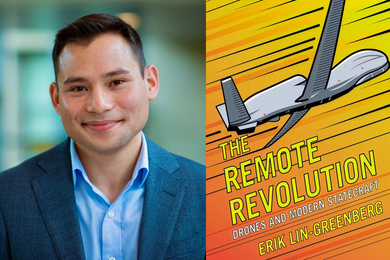MIT researchers have developed a wheelchair with unique responsiveness to human muscle pressure, so tasks that previously required the help of another person--in most cases, a nursing home or hospital aide--can now be accomplished unassisted.
The wheelchair, combined with a horseshoe-shaped bed, forms a system known as RHOMBUS (Reconfigurable Holonomic Omnidirectional Mobile Bed with Unified Seating). It was one of several health-care devices in development at MIT that were demonstrated at last week's Workshop on Healthcare Robotics at MIT, chaired by H. Harry Asada, Ford Professor of Engineering in the Department of Mechanical Engineering and sponsored by the National Science Foundation. Participants included medical-equipment vendors, health-care providers, and researchers in robotics, biomedical engineering, communications and software.
Another device from Professor Asada's lab shown at the workshop was a ring that allows constant remote monitoring of the wearer's vital signs (see story on page 5).
The powered wheelchair can be docked in the horseshoe portion of the system and reconfigured to a flat, stationary position forming a twin-size bed. The wheelchair's speed and direction are controlled by operating a joystick or by giving commands to the onboard computer.
The RHOMBUS system allows bedridden or wheelchair-bound persons to be in either a bed or a chair without changing seating and without having to lift themselves or be lifted by others.
Joseph S. Spano and Stephen A. Mascaro, both graduate students in the Department of Mechanical Engineering, developed the hybrid bed/wheelchair system with Professor Asada and Masayoshi Wada of Fuji. Professor Asada is also director of the d'Arbeloff Laboratory for Information Systems and Technology.
Mr. Spano developed the chair portion of RHOMBUS, which is equipped with a teleconferencing facility resembling an enlarged side-view mirror on a car, so the homebound person can communicate face-to-face with a distant caregiver, relatives and friends. Mr. Mascaro developed the vehicle portion, which is capable of omnidirectional (all-direction) motion.
To get a realistic view of how RHOMBUS might be used, Spano and Mascaro visited a local nursing home.
"I'm from car country, and that looked like an engine hoist," said Mr. Spano, a California native, when he saw the mechanism and the effort involved in transferring a patient from a bed to a wheelchair. RHOMBUS, he noted, would take less work and provide privacy and dignity to an elderly person.
"Control is implicit here," Mr. Spano said. "If your mind is sound but your body is weak, the chair will compensate." For example, slight muscular pressure on the back of the chair will engage it mechanically to lower toward the bed. When muscle pressure stops, or "zeroes out," the chair holds its position.
Both Mr. Spano and Mr. Mascaro acknowledged the leap between solving the mechanical problems of RHOMBUS and making the system user-friendly for elderly people They see the next challenge of RHOMBUS arising from fundamental questions as to how average people will use new health-care technology in their own home environments.
"Older people aren't going to interface easily with a big machine," noted Mr. Spano. For the sake of their comfort, the researchers would like to "get around using buttons and dials."
New features planned for addition to the current RHOMBUS prototype include force-guided docking control, which would allow the vehicle to be precisely "mated" with fixtures. This would include connecting a battery to a battery charger, liquid containers to pipes, and the vehicle itself to a toilet.
Funding for patent-pending RHOMBUS has been provided by a consortium of industrial sponsors.
A version of this article appeared in MIT Tech Talk on April 3, 1996.





